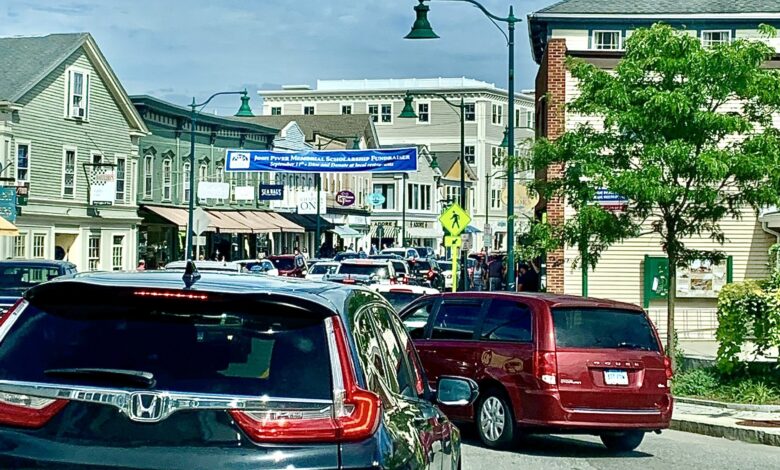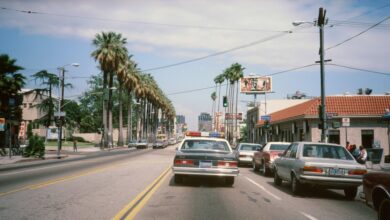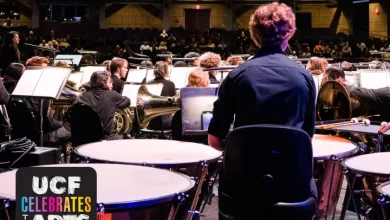Connecticut’s Top Tourist Attraction Debates Parking, Trains and Automobiles

MYSTIC — The word “parking” elicits annoyance from most every business owner in downtown Mystic who spoke recently with CT Examiner, no matter the solutions, small or large, discussed.
“I’ve run this store for three years and the parking situation has pretty much gotten worse every year. Everything has gotten a little bit more difficult the past few years because it’s gotten much busier downtown with traffic,” David Mensch, co-owner of Spencer & Lynn Wine and Spirit Merchants at 17 W. Main St., steps aways from the lift bridge in Mystic.
Mensch and his wife, Pamela Lynn, purchased the Mystic store before the state shut down for COVID in 2020. They also own stores in Groton and Noank.
Mensch suggested a variety of reasons for the worsening problem of parking, including staffing of the police force and a lack of enthusiasm for enforcing parking regulations in downtown Mystic.
But it all comes down to “just not a lot of spaces for the amount of people,” Mensch told CT Examiner.
A 2021 Mystic parking study concluded that many of those spaces are taken up by employees.
At a recent town council meeting Groton Police Chief Louis Fusaro enumerated the “cascading effects” of the problem, including late night noise complaints from spillover traffic into nearby residential neighborhoods.
Facing a lose-lose situation, several business owners told CT Examiner they were reluctant to speak on the record or jump in the fray.
One Mystic business owner, asking to speak anonymously, complained that the public was abusing the two-hour limits on many spaces and parking all day.
“There’s not as many people checking for parking on the police force. People know when they’re there and people know they can park all day on the street – especially in the fall or spring, you can park all day on the street,”
Adding to the problem, said Mensch, are 5 or 6 new restaurants that have opened in downtown Mystic on the Groton side in the past three years without the additional 25 parking spaces each that are supposed to be allocated for them.
“That has not actually happened. There’s been no new existing parking spaces other than the ones built in the Standard building and those are for residents,” he said. “We need to find a way to add parking at some point in a lot. I know they’ve shot down the garage many times but at some point it has to happen.”
Mensch suggested that building a lot near the Olde Mistick shops and ferrying people to the drawbridge was one solution, or building a lot on Allyn St.
“It’s just there has to be at some point a solution that doesn’t involve just sort of letting everyone figure it out for themselves,” he said.
Parking meters?
At the July 24 town meeting, Stonington property owners and residents rejected a parking ordinance that would have allowed electronic parking meters or kiosks in downtown Mystic and increased parking fines from $25 to $50.
Mensch told CT Examiner that he’d “be completely happy with them on the Groton side.”
Another business owner, speaking anonymously, said she would be in favor of paid parking, but only in the summer months.
“I am for the parking meters – for the summertime they would be wonderful. For wintertime, I’d like them not to be metered, and they do it in another state like that, so locals can come down,” she said. “I go to Newport in the summer and I pay to park, I don’t have a problem with it.”
But Richard Carillo, who owns of Mystic Florist on Pearl St., told CT Examiner he was not in favor of paid parking in downtown Mystic because it would change the essence of the town.
“Because this is a small town, this is not New York City. That’s dumb, they’re changing the town into a city,” he said. “There’s got to be some way that people understand that they can’t just park their car for the entire day here.”
Traffic and deliveries
A lack of loading zones for trucks delivering goods to stores and restaurants has only aggravated the problem, according to Mensch, who told CT Examiner that his shop receives as many as 10 or 12 different deliveries five days a week.
“Delivery trucks have no loading zone… There’s no 15 minute loading zone or 10 minute loading zone, so the trucks park in the middle of the road or they park in the side streets and block traffic, making a massive issue,” he said. “And that’s for everybody – from tractor trailers, FedEx trucks, UPS trucks, to our liquor distributors, food distributors. We are talking with hundreds of trucks… it does lead to a lot of intense screaming matches between different truckers and [people] parking, and trucks hitting cars because… they just have nowhere to go.”
Carrillo suggested adding 10 to 15 minute parking for people running quick errands downtown.
“So they could pick up their coffee, they could pick up a painting, they could pick up a book, they could run to the bank for 10 or 15 minutes,” he said.
Mensch suggested making both Gravel and Pearl streets one-way, creating a loop on and off Main St. and allowing diagonal parking on both streets.
Carrillo, on the other hand, was against the idea, warning that it would “clog it up even more” and make the back streets “a mess” and lower property values.
“This whole thing is just gonna be one hell of a major thruway. I’ve been here a while, over 38 years. I remember you used to be able to count how many cars went up and down Pearl Street in the day – two or three cars every five hours … and now it’s a major thruway,” he said.
Carillo also said that it was cheaper to get a parking ticket than to pay for parking in downtown Mystic. He said the parking fines needed to be raised.
“It just makes no sense. It’s got to bite enough, so then the person says, ‘I don’t want to pay the ticket. If it’s 50 bucks, I guarantee you they’ll think twice about it,” he said.
Big problems, Big solutions
The problems for downtown Mystic – now the state’s number one tourist attraction – are far larger than adding more parking spaces or reducing traffic congestion, Matt Beaudoin, the owner of Mystic Knotworks, told CT Examiner.
“Fundamentally, we have weakness going on with Mystic’s representation in Hartford. Mystic is really getting farmed for tax revenue that goes to Hartford, and the towns of Groton and Stonington are suffering for it,” he said.
Beaudoin pinned some hope on a task force pitched by State Sen. Heather Somers, R-Groton, to study the idea of a “Mystic intermodal transportation center” off I-95 at Exit 90, which could include water taxis to downtown Mystic.
“If that bears fruit that could really ease the burden too, and that could be the state financing the tax revenue that we’re generating from our town,” he said.
He said he was also in favor of the state extending train service to Mystic and adding stops in Groton, a solution that Beaudoin suggested could be added relatively easily.
“We’re looking at the number one tourist destination in the state of Connecticut. There’s so many opportunities the state is failing to provide that would reduce the traffic impact in town, that the implementation of the parking meters would have a negligible impact compared to what the state’s refusing to do for their highest earning tourist destination in the state,” he said.
In the latest budget, Gov. Ned Lamont and state legislators instead approved steep cuts to shoreline commuter rail service.
As for the electronic parking meters, Beaudoin said, “Maybe someday, but we have so many opportunities to solve the problem in other ways right now that we should really work on – the partnership with the local business community and local real estate owners to create solutions that don’t impact the residential town residents’ ability to access downtown.”
Critical mass
Other popular seaport towns have coped with similar problems, said Mensch
“Portsmith, Portland, Newport – every one of them at some point reached a critical mass where business just started to basically not be able to function and they had to do something – so the town can’t grow, period, without finding that balance,” he said. “And we’ve already hit that critical mass and gone backwards – down – because our local customers just don’t come here in the summertime… So we go to about 90% tourist business in our downtown store – we’re normally around 60/40 – so it’s dramatic.”
Mensch said that beyond building public parking lots, which could be costly, the town needed to find a way to access trolleys, transit or ferry to bring people downtown.
“And if not, just making the best traffic flow and the best designed parking spaces for people in town because there’s no other option,” he said.
Asking to remain anonymous, yet another business owner said this talk in the press of parking is not helping the situation and is keeping customers away.”
“People know parking is difficult in Mystic, and they say, ‘the more I hear it, why go to Mystic?’” she said.
But until something starts to happen, she admitted, “we’re at a standstill.”



